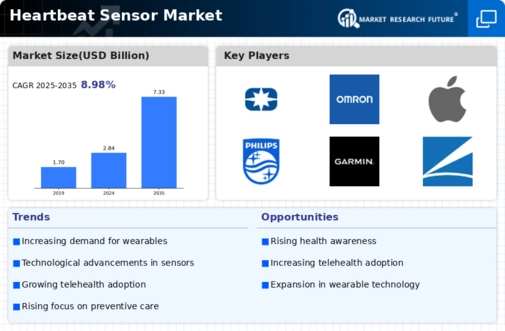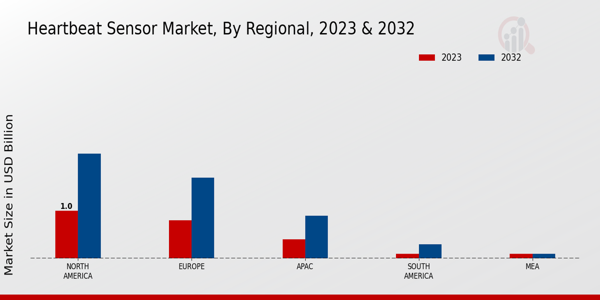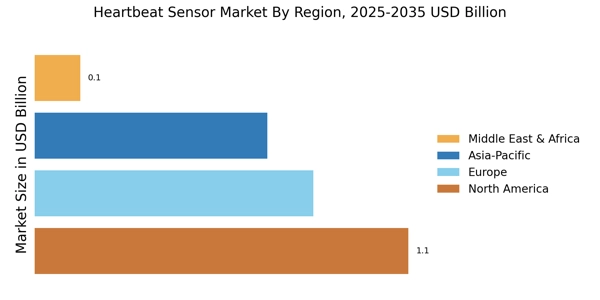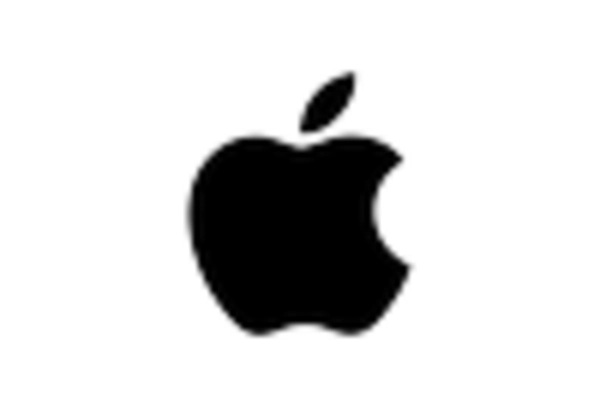Growing Health Consciousness
The Heartbeat Sensor Market is significantly influenced by the rising health consciousness among consumers. Individuals are increasingly prioritizing their health and wellness, leading to a surge in demand for devices that monitor vital signs, including heart rate. This trend is particularly evident in the fitness and wellness sectors, where consumers seek to track their physical activity and overall health metrics. The market for wearable devices, which often incorporate heartbeat sensors, is expected to reach a valuation of over 50 billion dollars by 2026. This growing awareness of health and fitness is likely to propel the heartbeat sensor market, as consumers look for tools that facilitate proactive health management.
Advancements in Sensor Technology
The Heartbeat Sensor Market is experiencing a notable transformation due to advancements in sensor technology. Innovations in microelectromechanical systems (MEMS) and photoplethysmography (PPG) are enhancing the accuracy and reliability of heartbeat sensors. These technological improvements are likely to drive the adoption of heartbeat sensors in various applications, including fitness tracking, medical diagnostics, and remote patient monitoring. As a result, the market is projected to grow at a compound annual growth rate (CAGR) of approximately 12% over the next five years. This growth is indicative of the increasing demand for precise health monitoring solutions, which are becoming integral to both consumer electronics and healthcare sectors.
Integration with Telehealth Services
The Heartbeat Sensor Market is benefiting from the integration of heartbeat sensors with telehealth services. As healthcare systems increasingly adopt telemedicine solutions, the demand for remote monitoring devices is on the rise. Heartbeat sensors play a crucial role in enabling healthcare providers to monitor patients' heart rates in real-time, facilitating timely interventions and personalized care. The telehealth market is projected to grow significantly, with estimates suggesting it could reach 250 billion dollars by 2027. This integration not only enhances patient care but also drives the adoption of heartbeat sensors, as healthcare providers seek reliable tools to support remote patient management.
Regulatory Support for Health Technologies
The Heartbeat Sensor Market is positively impacted by regulatory support for health technologies. Governments and regulatory bodies are increasingly recognizing the importance of health monitoring devices, leading to streamlined approval processes for innovative products. This supportive regulatory environment encourages manufacturers to invest in research and development, resulting in the introduction of advanced heartbeat sensors. As a consequence, the market is likely to witness an influx of new products that meet stringent safety and efficacy standards. This trend is expected to foster competition and innovation within the heartbeat sensor market, ultimately benefiting consumers with improved health monitoring solutions.
Rising Incidence of Cardiovascular Diseases
The Heartbeat Sensor Market is significantly driven by the rising incidence of cardiovascular diseases worldwide. As heart-related health issues become more prevalent, there is an increasing demand for devices that can monitor heart rates and provide early warnings of potential health risks. According to recent statistics, cardiovascular diseases account for nearly 31% of all global deaths, underscoring the urgent need for effective monitoring solutions. This alarming trend is likely to propel the heartbeat sensor market, as healthcare providers and consumers alike seek reliable tools to manage heart health proactively. The growing awareness of cardiovascular health is expected to further stimulate market growth in the coming years.


















Leave a Comment